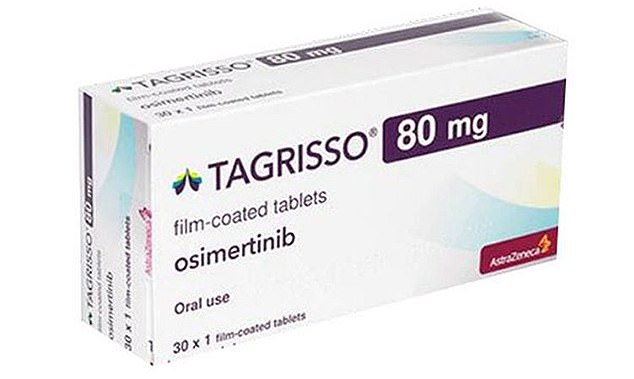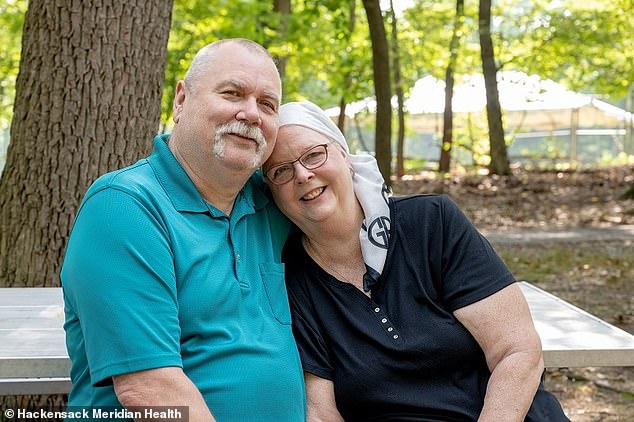Lung cancer pill that HALVES patients’ risk of death is hailed ‘earth-shattering’ by specialists
An ‘earth-shattering’ lung cancer pill could reduce the risk of the disease returning by more than 70 percent and halve the risk of death within five years of treatment, research shows.
Striking data, recently published in the New England Journal of Medicinehave led cancer specialists to call the drug, called osimertinib, “groundbreaking.”
The pill has been approved by American medicine chiefs for people with a genetic subtype of a lung tumor, which affects about 60,000 patients.
These tumors are caused by a genetic mutation that causes the release of a protein called EGFR, which helps tumors grow.
Lung cancer was once thought to be a ‘smoker’s disease’, but the discovery of genetic predisposition to the condition has shed light on a new patient group
But osimertinib, sold under the brand name Tagrisso, interferes with signals sent by the gene, blocks the release of the protein and destroys the cancer cells.
Dr. Faiz Bhora, chief of thoracic surgery and chairman of central surgery region at Hackensack Meridian Health in New Jersey, told Fox News Digital that the research results of the drug were ‘earth-shattering’.
‘Medical oncologists used to be happy with a survival of five to ten percent – and now we are talking about a survival improvement of more than 50 percent.’
Bhora, who prescribes the drug to his patients, said he had seen “groundbreaking” results in his own practice.
“We now have many targeted therapies that work well for patients with mutations in their tumors,” he said.

Thoracic surgeon Dr. Faiz Bhora says he has seen ‘groundbreaking’ results from the drugs in his patients
About 238,000 new cases of lung cancer are diagnosed in the U.S. each year — and 127,000 people die from the disease, according to the American Cancer Society.
About 25 percent of these patients have the EGFR mutation.
Dr. Bhora said, “We used to think that lung cancer was just a smoker’s disease. Now we know that more than 30 percent of people who get lung cancer have never smoked, and many of them are women.’
Those eligible for osimertinib – which can be taken as long as it continues to work – include EGFR patients at any stage of the disease, who have previously undergone treatment such as surgery.
About 95 percent of insurance plans cover Tagrisso, including Commerical, Medicare and Medicaid.
One patient benefiting from this is 67-year-old Kim Mosko from New Jersey.
In February 2023, the mother of two underwent surgery to remove a lung tumor that had grown outside the organ.

About 95 percent of insurance plans cover Tagrisso, including Commerical, Medicare and Medicaid.
She then underwent four rounds of chemotherapy, which ended in late June.
In July, her doctors discovered the genetic mutation and suggested she take Tagrisso.
She needed “no convincing at all” to start the treatment, she told Fox, which is covered by her insurance.
Ms Mosko has been taking the pill for three and a half months now and she hopes to be able to take it every day for the next three years.
‘I don’t have to have hope. I absolutely believe that this drug will ensure that the lung cancer does not return. “I plan to live many more years,” she said.
She has experienced some ‘manageable’ side effects, including rash, diarrhea and fatigue.

Kim Mosko, 67, has been taking the drug since July and says it has kept her cancer at bay
Lung cancer is the leading cause of cancer-related deaths worldwide. In the US, one in six people will be diagnosed with the disease during their lifetime.
A recent report from the ACS shows that young women are more likely to suffer from lung cancer than men.
Men were almost twice as likely as women to develop the disease in the 1980s, due to higher rates of smoking and higher workplace exposure to substances such as asbestos.
But with declining cigarette use and safety regulations, the pattern has reversed, with young and middle-aged women now more likely to be diagnosed with the disease than men.
In 1992 there were about 65 new cases of lung cancer for every 100,000 people and by 2019 this had fallen to about 42.
